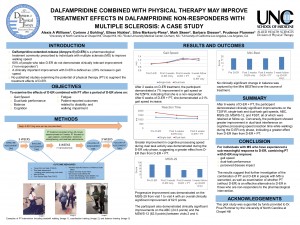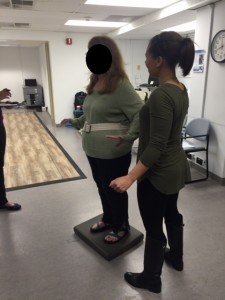DALFAMPRIDINE AND PHYSICAL THERAPY: EFFECTS ON GAIT SPEED FOR ADULTS WITH MULTIPLE SCLEROSIS: A CASE STUDY
By: Alexis Williams, SPT, ATC
Background: Dalfampridine extended release (D-ER) (Ampyra 10 mg twice daily), is a pharmacological intervention that has been show to improve gait speed in people with multiple sclerosis and is frequently prescribed to patients with gait difficulties (1). D-ER is a voltage-gated potassium channel blocker that functions by increasing action potential conduction in demyelinated axons in patients with MS (2). Two phase 3 clinical trials have demonstrated a clinically important improvement in gait speed (>20% increase in Timed 25-foot Walk test) for individuals taking D-ER, but only in 38% of people who take it (“responders”)(2). More than 60% of people who take this medication do not demonstrate clinically relevant gait speed improvement (“non-responders”) (2).
Statement of Need: Multiple Sclerosis (MS) is a progressive immune-mediated neurological disorder that results in episodes of inflammation (3). Inflammation causes demyelination of nerve fibers leading to lesions within the central nervous system and slowing or disruption of the transmission of nerve conduction causing a wide range of symptoms including muscular weakness, spasticity, poor balance and coordination, and fatigue (3,4,5). Additionally, a decrease in gait speed has been used as a clinical benchmark of the extent of disease progression and the impact of MS on a person’s daily activities and function (6). In fact, individuals who demonstrate slow gait speeds are more likely to be unemployed, to be covered by Medicaid or Medicare, to be divorced, to walk with an assistive device, and more likely to require assistance to complete activities of daily living (6).
______________________________________________________________________________________
This year, I had the opportunity to participate in a pilot study through my research elective in the fall, led by Dr. Prue Plummer. The purpose of this study is to examine the feasibility and efficacy of combining D-ER with gait training for improving in gait speed, dual-task performance, and balance compared to gait training without D-ER in adults with multiple sclerosis (MS). During the EBP II course, I completed my Critically Appraised Topic (CAT) on the efficacy of D-ER and physical therapy gait training to improve gait speed. Through this research, I discovered that there is limited support for physical therapy interventions to improve gait speed in individuals with multiple sclerosis (MS) and no current data that combines D-ER and physical therapy gait training.
My capstone project is a case study that examines the efficacy of improving gait speed by combining gait training interventions to with D-ER to enhance the effects of the drug for non-responders. I participated in the development of the research protocol, training, execution, and data analysis of this project while focusing on gait speed. Other components of this study included an analysis of balance and dual-task performance.
We submitted our abstract for our case study and presented our data at the 2016 Human Movement Science and Biomechanics Research Symposium at UNC-Chapel Hill. Click on the image below to see our poster.
(Click to enlarge)
This pilot case study is the start of a larger study to determine the most effective way to improve gait speed of people with Multiple Sclerosis. The paper will be submitted for publication to the International Journal of Multiple Sclerosis Care (IJMSC). (Please check back soon for completed paper after publication)
______________________________________________________________________________________
Self-Reflection/Evaluation: Through the development of this project, it has been a great experience receiving firsthand exposure to the highs and lows of developing an IRB approved study. We edited numerous versions of our initial protocol, abstract, poster, and paper for publication. Additionally, we initially were hoping to compare participants receiving D-ER and PT directly to a control group who were just receiving PT. However, I quickly learned that recruitment of participants does not always go as planned and we were unable to analyze results in time for our presentation. Flexibility is a required characteristic to be involved in research!
Fortunately, this project is only the beginning. The long-term goal of Dr. Prue Plummer is to create a larger study with the current protocol, directly comparing the effects of D-ER to PT with individuals who are both responders and non-responders to the medication. Additionally, results will be compared to a control group who is not prescribed D-ER and only receiving PT intervention. I hope to continue to be involved in the development of this study. We have briefly discussed presenting our results as a platform presentation at CSM next year!
I felt a strong personal connection with this project. I have had many patients who have been on this medication, seen improvements in their mobility, and then discover that their insurance company will not cover the cost of this very expensive drug for various reasons. It is exciting to be a part of a study that will add to the current body of evidence regarding best treatments for individuals with a chronic disease such as MS. This study will help determine clinical questions of the most effective intervention to improve gait and provide clinicians with an easily reproducible gait training protocol.
We received evaluations from our poster presentation which can be viewed here. We will also be seeking final evaluations/feedback from our capstone committee, as well as our readers once published in IJMSC.
Acknowledgments: This project would not have been possible without the guidance and support of Dr. Prue Plummer, PhD, PT. She has been an amazing advocate for my growth as a student and my exposure to research. I will be forever grateful for the passion she has sparked in me. Next, I would like to acknowledge my classmates, Corinne Bohling and Ellese Nickles, who provided their assistance in the formulation and presentation of our case study. After many hours of edits and revisions, I am thankful for the opportunity to work alongside them. Please take note of their focus on the effect of balance and dual-tasking related to the combination of D-ER and PT. Thank you to the faculty and classmates who came to our presentation at the 2016 Human Movement Science and Biomechanics Research Symposium-your support and feedback was greatly appreciated! I would also like to thank our committee members Catherine Jacobs, DPT and Amy Thomas, PT for their review our final project.
Finally, I am grateful for the opportunity to participate in the MS STEP UP track for the exposure to working with individuals who have Multiple Sclerosis and the Volunteer Leadership Team for their continued support.
______________________________________________________________________________________
References:
(1) Goodman AD, Brown TR, Schapiro R, T., et al. A pooled analysis of two phase 3 clinical trials of dalfampridine in patients with multiple sclerosis. International Journal of Multiple Sclerosis Care 2014;16:153-160.
(2) Bostock H, Sears TA, Sherratt RM. The Effects of 4-aminopyridine and Tetraethylammonium Ions on Normal and Demyelinated Mammalian Nerve Fibers. J Physiol. 1981;313:301-315.
(3) National Multiple Sclerosis Society. What is MS: Definition of MS. Natl Mult Sclerosis Soc Website. http://www.nationalmssociety.org/What-is-MS/Definition-of-MS. Accessed December 4, 2016.
(4) National Multiple Sclerosis Society. Symptoms and Diagnosis: MS Symptoms. Natl Mult Sclerosis Soc Website. http://www.nationalmssociety.org/Symptoms-Diagnosis/MS-Symptoms. Accessed December 4, 2016.
(5) Plow MA, Resnik L, Allen SM. Exploring physical activity behaviour of persons with multiple sclerosis: a qualitative pilot study. Disabil Rehabil. 2009;31(20):1652-1665.
(6) Goldman M, Motl R, Scagnelli J, Pula J, Sosnoff J, Cadavid D. Clinically meaningful performance benchmarks in MS: timed 25-foot walk and the real world. Neurology. 2013 Nov; 81(21):1856-63.




6 Responses to “DALFAMPRIDINE AND PHYSICAL THERAPY: EFFECTS ON GAIT SPEED FOR ADULTS WITH MULTIPLE SCLEROSIS”
Lexie
Debby,
Thanks for taking the time to review my project! One thing I would change to strengthen the design of a study would to increase the time periods within our protocol. The research of this drug states that it takes approximately 2-6 weeks for drug effects to occur. Maximizing the drug only period would help us to better determine the effects of D-ER on her walking.
Additionally, tracking her activity outside of her PT interventions would help to identify any potential external factors that could affect her outcomes (i.e increase in activity level). Finally, with MS, we know that a person’s functional mobility can fluctuate throughout the day. Ensuring that her measurements were taken at the same time each assessment visit may present a more accurate presentation of her outcomes over time.
In regards to stability of her functional status, reporting of functional status overtime (prior to PT) could better indicate the progression of the disease and likelihood of his/her ability to complete the study. Additionally, indicating information regarding significant past medical history, family support, history of PT, and other current medications can also provide information regarding the stability of her functional status.
Lexie
Debby Givens
Lexie:
Nice job and your poster was very readable. Since this was a single case study, if you could repeat this again (and have the resources you need) how would you design the case study to strengthen the design? How could you address the concerns a reviewer might have regarding things like the stability of her functional status before introduction of the PT?
Debby
Lexie Williams
Annemarie,
Thanks for review my project and encouraging words!
Great point! The mechanism of action of D-ER is not fully understood, however, it is believed to increase the nerve impulse conduction in demyelinated axons by blocking potassium channels. Knowing this information, one could suspect that this would improve other symptoms related to MS that are caused by demyelinated axons. While my capstone focuses on gait speed, the concentration of research related to this drug, I encourage you to look at Ellese and Corinne’s projects who looked into balance and cognitive processing speed with the use of D-ER. Larger studies are required to determine the full effect of this pharmacological intervention.
There have been several small, lower quality studies that have looked into the effects of D-ER beyond gait speed. If you are interested in reading more about it, check these articles out:
Cameron MH, Fitzpatrick M, Overs S, et at. Dalfampridine improves walking speed, walking endurance, and community participation in veterans with multiple sclerosis: a longitudinal cohort study. Mult Scler. 2014; 20(6): 733-8.
Prosperini L, Gianni C, Fortuna D, et al. Oral dalfampridine improves standing balance detected at static posturography in multiple sclerosis. Multiple Sclerosis International. 2014; 2014:802307.
Ruck T, Bittner S, Simon OJ, et al. Long-term effects of dalfampridine in patients with multiple sclerosis. J Neurol Sci. 2014; 337(1-2): 18-24.
Annemarie Erich
Alexis,
I must second Krissy’s comments about the amount of time and effort you have put into this project and your academic career as a whole. You always go above and beyond and that is admirable.
I have only ever met 3 people with M.S. and I have seen the variability in their physical capabilities from day to day. Ampyra is the “walking drug.” However, I have heard one person with M.S. and their family members speak to benefits of Ampyra in regards to improving performance of activities other than walking. Any thoughts about this?
Good luck in your residency. I know we will see great things from you!
Lexie Williams
Krissy,
Thanks so much for reviewing my project and also doing a little research yourself! I was also shocked to know that this medication is often prescribed without a referral to physical therapy and that it has not been directly compared to PT intervention. This medication is costly and comes with serious side effects such as seizures.
Our medication only period was to assess the response of the participants to the drug. According to Acorda, the drug manufacturer, 2-6 weeks is the estimated amount of time it takes for D-ER to show therapeutic benefits. A longer drug only period may allow us to better determine the true effects of the medication on gait speed. This would be a great edit to the final protocol. Additionally, multiple drug only measurements of her gait speed would also help to clearly determine the effect of the drug since we know that MS-related symptoms can change on a daily basis. However, due to timing and purpose of the pilot study, a longer drug only phase was not implemented.
Participants were instructed to maintain their normal physical activity routine during the study period. Our initial protocol included the use of an activity monitor to gather information about her normal activity during the day, however, this was not utilized for our first participant. I do think that it would be beneficial to analyze physical activity throughout the study protocol.
Thank you so much for your encouraging words. It all would not have been possible without your support along the way!! We almost made it!!!
Lexie
Krissy Ayers
Lexie,
I am thoroughly impressed with the amount of research, time, and dedication that was involved in your case study. To become better educated on your project, I researched Dalfampridine, AKA Ampyra. I am very surprised there is no research that directly compares Dalfampridine with physical therapy, considering this drug is commonly taken in those who have MS to increase walking speed. Since this is a new and exciting research topic, I am looking forward to reading the entire study once it is published, because I am curious of the limitations that you ran into. For example, in the abstract the patient did not improve gait-speed during the 2 week Dalfampridine treatment, but did experience clinically significant improvements with the addition of PT over 6 weeks. Why was 2 weeks chosen for the Dalfampridine treatment? Is there research to assume the medicine should cause significant positive changes in that time frame? I noticed on Amprya’s website they commented that some people experience walking improvements within a couple of weeks, while others notice improvement up to 6 weeks after starting Amprya. Also, what was her level of activity during the medicine treatment compared to the medicine+PT treatment? Did you advice her limit her physical activity during the medicine treatment time? Lots of little questions, which I know will be answered when this research is published. 🙂
On another note:
Lexie, I SO proud of all your accomplishments over these past 3 years in school, including this case study and your acceptance into a top-ranked neuro residency. With all of your hard work and dedication, you really deserve the best! Your patients will be blessed to have you as their provider!
Thank you for sharing your project!
Krissy